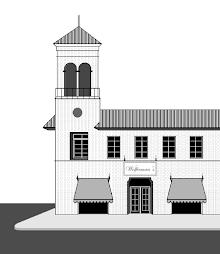At the end of World War II, as America embarked upon an unprecedented period of economic growth and expansion, the movie industry was in the midst of a slump. Ticket sales fell dramatically between 1946 and 1956. To try and buck this trend, several widescreen formats were developed. Cinerama debuted in 1952, followed by CinemaScope, VistaVision and Todd-AO.
*Cinerama. The first widescreen process was introduced with the September 30, 1952 showing of the Cinerama Releasing Corporation's "This Is Cinerama." Originally, three cameras, three synchronized projectors and a huge, curved screen were used. At first, existing theaters were converted to the Cinerama format.
By the 1960s, a single projector had been perfected. Cinerama-capable venues were built at shopping centers such as WINROCK CENTER {Albuquerque, New Mexico} and SHARPSTOWN CENTER {Houston, Texas} in the 1960s. The final Cinerama theater, at SOUTHCENTER MALL {Tukwila, Washington}, was dedicated in April 1970.
*CinemaScope. This widescreen process premiered, on September 16, 1953, with Twentieth Century Fox's "The Robe." CinemaScope used a single camera, projector and an anamorphic lens to produce a widescreen image. A wider screen was also necessary for CinemaScope features.
*VistaVision. Paramount Pictures' brand of widescreen film presentation made its debut with the first showing of "White Christmas," on October 14, 1954. VistaVision also used a single camera (with modifications), a single projector and a screen wider than the conventional model.
*Todd-AO. The fourth major widescreen format of the 1950s was developed by Michael Todd and the American Optical Company. It premiered October 11, 1955 with Twentieth Century Fox's "Oklahoma." This format utilized a wider film negative (70mm) than that used for Cinerama, CinemaScope and VistaVision (whose films were shot on conventional 35mm filmstock). Theatrical presentation of Todd-AO required a single projector and widened movie screen.
See Fair Use Disclaimer at end of article
The following innovations were also devised to compete with the small-screen television medium;
*3-D. The first practical showing of a three-dimensional film took place on November 30, 1952, with the premier of Arch Oboler Productions' "Bwana Devil." The 3-D process created the illusion of depth perception, via two projectors equipped with special polarizing filters and the disposable "anaglyph" glasses worn by viewers.
*Stereophonic Sound. Walt Disney Studio's "Fantasia" premiered with a stereo soundtrack on November 13, 1940. However, it was the September 1952 showing of "This Is Cinerama" that introduced the first practical application of a stereo motion picture soundtrack.




